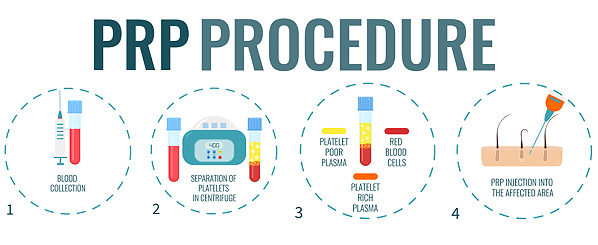Regenerative Medicine – PRP
Platelet Rich Plasma (PRP)
What is PRP?
Platelets are a naturally occurring component of our own blood and play an important role in wound healing and tissue regeneration. Platelet Rich Plasma (PRP) therapy is the process of isolating platelets from the blood and concentrating these platelets to much higher concentration levels than normal, through the process of centrifugation. The result is Platelet Rich Plasma.
How does PRP work?
Platelets play a very important role in healing at any site of injury. The high number of platelets in PRP results in increased number of secreted growth factors, thereby increasing the healing process. These growth factors are essential for tissue rejuvenation & repair. When injected into our skin, they can help stimulate new tissue and collagen production.
What are the benefits of PRP?
- Improve skin tone and texture
- Reduce fine lines and wrinkles
- Tighter and firmer skin
- Anti-aging
- Rejuvenate tired eyes
- Increase collagen production
- Reduce hair loss and improve hair growth
- Long lasting results
- No foreign material used
What conditions do PRP help?
- Dark under eye circles
- Fine lines or wrinkles
- Uneven or dull skin tone
- Sun damaged skin
- Large pores and coarse skin textures
- Pigmentation/age spots
- Hair loss or balding
- Osteoarthritis/joint pains
- Vaginal rejuvenation
- Penis enhancement
What does the process involve?
- Blood collection:
You would have a small amount of blood (approximately 30-40mls) drawn from your arm. - Centrifugation of blood:
The test tube containing your blood would be placed in a highly specialised medical device called a centrifuge, which separates your blood into layers. One of these layers contains a high concentration of platelets. - PRP extraction:
After centrifugation, the platelet rich plasma portion of the blood will be extracted into a syringe. - Blood injected:
Our doctors will inject the blood that contains the high concentration of platelets manually into your area of interest, using a syringe with needle.
What are the side effects of PRP injection?
As this treatment involves injection, side effects such as infection, bleeding and injury to blood vessels are possible albeit rare.
What are the precautions to PRP treatment?
PRP injection is not recommended for patients who have blood-related disorders, anaemia or cancers of the blood or bone. If you are taking any blood thinners or non-steroidal anti-inflammatories (NSAIDs), please also let our doctors know during the consultation.
What is the expected downtime?
Most of our patients are able continue with their daily activities after the procedure. However, some patients may experience mild redness, swelling or bruising after the treatment that usually resolves within a week.
FAQs
How long is the procedure?
The procedure usually takes 30 to 60 minutes depending on the area and condition being treated.
Is PRP injection painful?
Depending on the area of injection, the level of discomfort would vary. However, the procedure is generally very well tolerated by most patients. A topical numbing cream will also be applied before the procedure to ensure that you remain comfortable throughout the whole process.
Is PRP safe?
Yes, PRP injections are safe. PRP is your own unique tissue, therefore you are using your own blood to repair and improve your skin tissue. Platelet Rich Plasma has been used in hundreds of thousands of procedures around the world for over 30 years, predominantly in maxilla-facial, orthopaedic, and cardiac surgery.
When can I see the effects of PRP?
Your skin texture will improve as new tissue cells grow and visible results may take 3 to 6 weeks. The results continue to improve over time and last approximately 1 to 2 years.
How many sessions do I need?
Every individual is different; however, we generally recommend 3 to 6 consecutive treatments done one month apart to attain the best maximum results.

